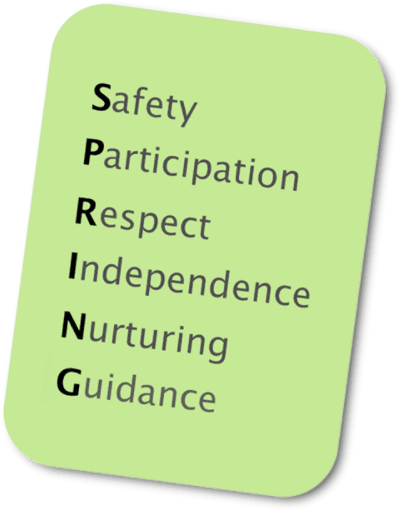In our last practice matters, I looked at the definition of Autistic spectrum Disorder.
In this issue I will explore the meaning of autistic spectrum disorder, the main areas affected by Autistic spectrum disorder and tips for supporting people with autistic spectrum.
What is autistic spectrum disorder?
Autistic spectrum disorder is a relatively new terminology to describe people who have the following futures in common:
- People affected by their ability to understand and use of none verbal communications,
- Lack of ability to interpret social behaviour which in turns impact on their ability to interact with other people.
- Finds it very difficult to adjust and adopt their behaviour to suit specific situations and events. (These are known as the triad of impairments). They may also Struggle to adapt to changes.
Different sub – groups can be found within the spectrum such as Asperser’s syndrome, high functioning autism, classical autism and Kanner’s syndrome.
Children with autistic spectrum disorder may also be described as having autistic traits or futures. The term autistic tenderness is very unhelpful as it is very vague and implies uncertainties in the diagnoses. Therefore it is more useful to consider such children as having autistic spectrum disorder.
Tips for Practical matters
People with autistic spectrum have a different perspective and experience of the world from ours. Therefore it is important to develop and value their interest and hobbies and not to focus on their weaknesses or trying to change them (to become like ours) which they will challenge and may not necessarily want to change. In their own eyes their world is perfect as their perception of things is different from the way you may perceive them. Therefore your perception of normality may not be what they see as normal. Therefore you need to get into their world and try to see situations in their own point of view. This will enhance your insight of their world and in return they will feel relaxed and happy in your company. The work with disabled people must be empowering, enabling and inclusive to enhance the areas affected by autistic spectrum disorder.
The main areas affected by autistic spectrum disorder.
1) None verbal and verbal communication
At times we often will say what we don’t mean. People with autistic spectrum disorder find this very confusing and may take us literally. For example, comments like ” can you sit down? Your child may respond “yes” and not act on your instruction. Teacher’s instructions such as “raise your hands” may result in utter confusion and dismay. In reading and listening to a story, a child may have excellent memory for the details, but have problems in understanding the main points. Hence will not act on your instructions,
Some people with autistic Spectrum Disorder may repeat what you say or what they hear or your questions (echolalia) which may serve a function in helping them to work out the meaning or to reduce anxiety. Speech may be delayed and some do not develop speech at all. Others with speech have difficulties in using it effectively to communicate with others.
Tips:
If your child’s speech is delayed or have no speech, you will need to use means of using pictures, photos, gestures, spoken or written words to communicate and may need to learn sign languages with your child.
In all listed above, Health and Safety is paramount when working with people with Autism.
2) Social Understanding and behaviour.
People with autistic spectrum may have difficulties understanding you and understanding your underlying principle. Ordinarily, we develop this understanding without being trained and do this quite easily. Some people with autistic spectrum also talke to themselves which increases social isolation and exposes them to risk of harm if not appropriately supported.
However our behaviour is very much influenced by what we think others might think about us. But for people with autistic spectrum disorder, other people’s influence and opinion may not have any influence on them and they may very well do what they pleases or wants.
Hence Children with Autistic disorder may struggle to play and communicate effectively with other children who may be confused by their behaviour and avoid or tease them as a result.
Tip:
Therefore, you as a parent will need to support and help your child to play together successfully with his/her peers. You will need patient, empathy and be consistent in teaching your child appropriate ways to play with other children. Do not isolate him/her as the more you isolate him/her, the difficult integration becomes and the isolation increases. However, the more you take your child out to socialise with other children the better as he/she will become very good at it.
Remember, people who are not aware or do not understand autistic spectrum disorder and do not know your child may misunderstand your child’s behaviour and see their behaviour as being silly, naughty, untrained and lacks discipline and at times may attribute this to your inability to set appropriate boundaries for your child and at worst poor parenting. Parents may feel embarrass and disappointed and may take the worst step by keeping the child at home. This does not help, believe me it makes the behaviour worst as the child learns most of their social behaviour through play and interaction with other children and adults around them.
Please be mindful that the child may not understand the situation or task or unable to read your intentions or mood correctly and therefore must not be blamed for their behaviour.
3) Adjusting to situations and circumstances.
Children with an autism spectrum condition often do not play with toys in a conservative way. But instead squash and spin objects or watch moving part of toys or machinery for long period and with intense interest. Their play tends to be isolated and alongside others. Children with autistic spectrum disorder may imitate certain scenes they have observed more able children do with others. Eg they may play as the main actor but finds it had for playing with a friend at being the main actor or partners. Some children develops obsessional interest in hobby and interest, some children with autistic spectrum disorder may show an extreme reaction to change in routines which have become familiar to them or when something they rely on is changed. Lots of changes at once may cause a relapse which will impact on not just the behaviour but the life skills learned and taught over the years.
Tip:
Care must be taken to affect any changes and any change must be introduced very slow and minimised to avoid any disruption to routine, stability and consistency.
4) Sensory perception and Response
Some children with autistic spectrum disorder are over sensitive to certain sounds, sights and textures. This has implications for the children’s home, school and environment and may explain their responds to changing clothes or food and their responds to noise. Therefore a child with autistic spectrum may not make appropriate eye contact instead he/she may stare or looking too briefly or looking away when talking to other people.
In the past, there was an emphasis about teaching the children to look when talking to other people. There was also emphasis on culture. For example, in African countries, children are not expected to make eye contact when communicating with an adult as making eye contact could be interpreted as lack of respect whilst in western world lack of eye contact means sign of disrespect or un-trust worthiness.
Tips:
Therefore, it is important to note that children with antistatic spectrum disorder may not be able to look and talk to you at the same time. This does not mean that they disrespect you or they have something to hide. By understanding each individual child’s perception and skills, you can alter how you communicate with them and increase the effectiveness of your communication and so reduce the problems and difficulties you and the child experience.
It is important to understand that Social encounters and communication by definition requires more than one person. Therefore referring to a child with an autistic spectrum disorder as having a social and communication problem is wrong, misleading and unfair as it apportions the blame on the child only. Every effort needs to be made in providing positive experience to the child and to avoid “scapegoating” of the child /people with learning difficulties.
The most difficult and challenging time is transition age as lots of changes occur at this time and can cause relapse if not appropriately managed.
What is transition?
Between the ages of 14 and 25 young people are faced to make one of the most difficult decisions in their life regarding their future for example, their education or employment, or whether to leave home. Furthermore, it is mainly the time when young people are expected to take more responsibility for their own health and finances and establish themselves as autonomous individuals.
For disabled young people it can be a confusing difficult and complicated time, as they often receive support from a number of different agencies, including health, social care and education services, and they will transfer from children’s to adult services. It is clear therefore that supporting transition to adulthood for disabled young people requires an ongoing multi-agency approach that can address these different aspects of the young person’s life. There is a need to maintain consistency and stability. Service such as Springcare Support Services was set up to bridge the gap and ensure that the support continues from child to adulthood.
Referring children with disabilities to organisations such as Springcare Support Services will not only ensure stability but will ensure that one consistent support remains in place when everything else may be changing during transition stage.
Therefore in the next practice issue, I will look at the impotence of transition and practical implication to failed transition.

